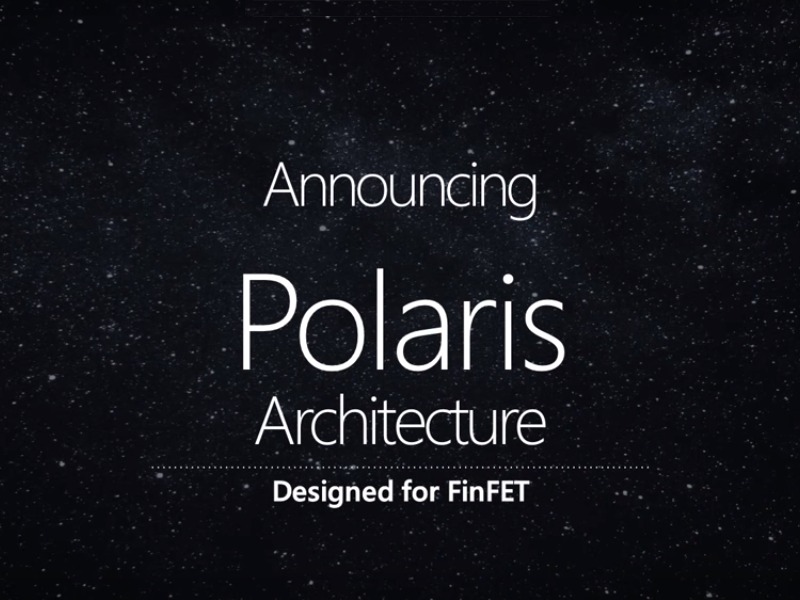- Home
- Laptops
- Laptops News
- AMD's Next Generation Polaris GPU Demoed at CES 2016
AMD's Next-Generation Polaris GPU Demoed at CES 2016
By Gadgets 360 Staff | Updated: 5 January 2016 12:31 IST

Click Here to Add Gadgets360 As A Trusted Source

Advertisement
AMD took the wraps of its upcoming GPU architecture called Polaris at CES 2016. This chip is based on AMD's fourth generation GCN (Graphics Core Next) architecture and is built using a 14nm FinFET fabrication process, which is big leap forward from its current 28nm process. AMD claims that shifting to this process has the potential to deliver more than double the performance per watt in gaming, VR, and multimedia applications. The new GPUs are already being sampled out to OEMs and we can expect them to appear in products by mid-2016.
Other than the new GPU architecture, Polaris GPUs will also pack in the latest display formats like HDMI 2.0a for HDR video, DisplayPort 1.3, and next-gen multimedia features like 4K H.265 encoding and decoding. In AMD's demo, we can see two machines running a demo of Star Wars Battlefront in which, the Polaris GPU powered machine averages a system power draw of 85W whereas a similarly powered GPU from the competition averages nearly twice the power. Granted, this demo is tailor made to make Polaris look amazing but it also shows the potential of the 14nm FinFET process. Going forward, we can expect similar gaming performance from ultrathin notebooks and small form factor PCs as we would from the typical bulky machines of today.
AMD will have stiff competition, however as Nvidia has also official announced its Pascal GPU, built on the 16nm FinFET process. Unlike AMD, Nvidia will be pushing its GPU to the automobile industry first with the Drive PX 2 artificial intelligence system for self-driving cars. It will be interesting to see how both Polaris and Pascal develop into 2016's desktop graphics cards.
Other than the new GPU architecture, Polaris GPUs will also pack in the latest display formats like HDMI 2.0a for HDR video, DisplayPort 1.3, and next-gen multimedia features like 4K H.265 encoding and decoding. In AMD's demo, we can see two machines running a demo of Star Wars Battlefront in which, the Polaris GPU powered machine averages a system power draw of 85W whereas a similarly powered GPU from the competition averages nearly twice the power. Granted, this demo is tailor made to make Polaris look amazing but it also shows the potential of the 14nm FinFET process. Going forward, we can expect similar gaming performance from ultrathin notebooks and small form factor PCs as we would from the typical bulky machines of today.
AMD will have stiff competition, however as Nvidia has also official announced its Pascal GPU, built on the 16nm FinFET process. Unlike AMD, Nvidia will be pushing its GPU to the automobile industry first with the Drive PX 2 artificial intelligence system for self-driving cars. It will be interesting to see how both Polaris and Pascal develop into 2016's desktop graphics cards.
Comments
Get your daily dose of tech news, reviews, and insights, in under 80 characters on Gadgets 360 Turbo. Connect with fellow tech lovers on our Forum. Follow us on X, Facebook, WhatsApp, Threads and Google News for instant updates. Catch all the action on our YouTube channel.
Related Stories
Popular on Gadgets
- Samsung Galaxy Unpacked 2025
- ChatGPT
- Redmi Note 14 Pro+
- iPhone 16
- Apple Vision Pro
- Oneplus 12
- OnePlus Nord CE 3 Lite 5G
- iPhone 13
- Xiaomi 14 Pro
- Oppo Find N3
- Tecno Spark Go (2023)
- Realme V30
- Best Phones Under 25000
- Samsung Galaxy S24 Series
- Cryptocurrency
- iQoo 12
- Samsung Galaxy S24 Ultra
- Giottus
- Samsung Galaxy Z Flip 5
- Apple 'Scary Fast'
- Housefull 5
- GoPro Hero 12 Black Review
- Invincible Season 2
- JioGlass
- HD Ready TV
- Laptop Under 50000
- Smartwatch Under 10000
- Latest Mobile Phones
- Compare Phones
Latest Gadgets
- Redmi Note 15 5G
- Redmi Note 15 Pro 5G
- Redmi Note 15 Pro+ 5G
- Lava Play Max
- Poco C85 5G
- Honor Magic 8 Lite
- Jolla Phone
- Realme P4x 5G
- Asus ProArt P16
- MacBook Pro 14-inch (M5, 2025)
- OnePlus Pad Go 2
- Poco Pad M1
- Just Corseca Skywatch Pro
- Honor Watch X5
- Acerpure Nitro Z Series 100-inch QLED TV
- Samsung 43 Inch LED Ultra HD (4K) Smart TV (UA43UE81AFULXL)
- Asus ROG Ally
- Nintendo Switch Lite
- Haier 1.6 Ton 5 Star Inverter Split AC (HSU19G-MZAID5BN-INV)
- Haier 1.6 Ton 5 Star Inverter Split AC (HSU19G-MZAIM5BN-INV)
© Copyright Red Pixels Ventures Limited 2025. All rights reserved.

















